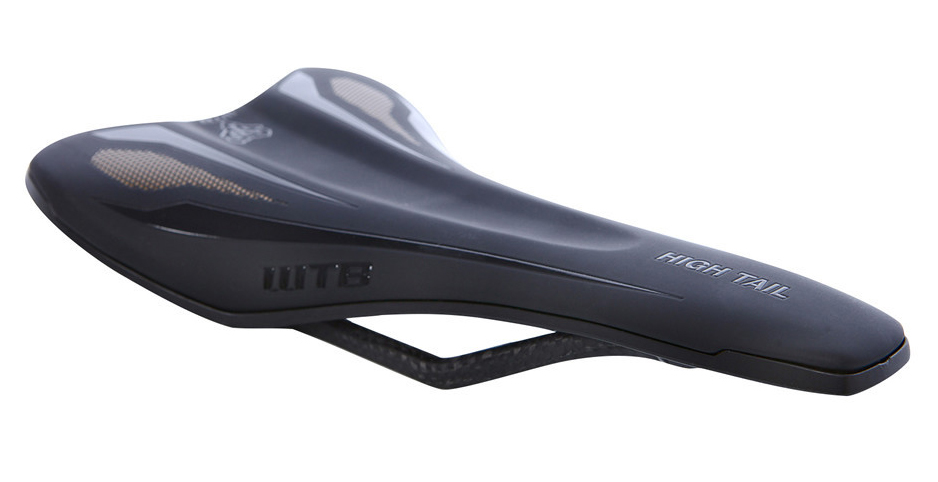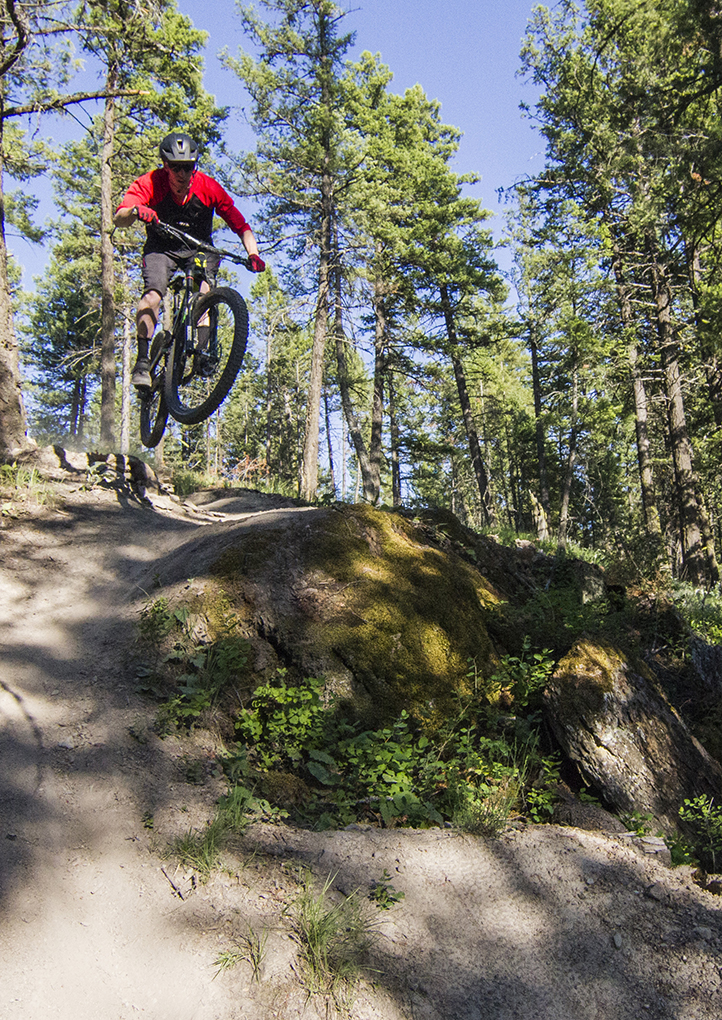
WTB High Tail Carbon Saddle
Dimensions: 128mm wide x 255mm long
Blister’s Measured Weight: 160 grams
MSRP: $119.95-$249.95 ($249.95 – tested)
Mounted To:
• Canfield Jedi (Thomson seatpost)
• Devinci Spartan (Reverb seatpost)
Duration of Test: ~1 month
Test Locations: Whitefish, MT; Fernie, BC; Kellogg, ID
Reviewer: 5’9” 155 lbs
WTB’s new High Tail saddle incorporates a lot of the features that WTB has been building into their saddle lineup for quite a while.
But the big story for the High Tail is that it’s designed to better accommodate big wheeled, longer-travel bikes.
The story goes that Chris Cocalis of Pivot Bikes and suspension designer Dave Weagle approached WTB to come up with a saddle that offered more tire clearance, to keep the tire from buzzing the seat.
The fact that this has become an issue is rather predictable: wheel sizes are getting bigger, and more and more manufacturers are working (despite the larger wheels) to keep the rear ends of their bikes extra short.
Add to this the fact that tire sizes certainly aren’t getting any smaller, and that suspension travel generally isn’t getting any shorter. So you’ve got a bigger wheel that’s crammed in closer to the seat tube, and, unsurprisingly, when the suspension bottoms out, you run into tire clearance issues.
This is particularly an issue on downhill bikes with small frames. In the realm of DH bikes, I know of at least one company (GT) that shortened the travel of their DH bike when they changed the wheelsize to 27.5, at least in part due to clearance issues.
Pivot had a similar issue, but instead of reducing the travel on their Phoenix, they worked with WTB to come up with a new saddle design.
The Design
So what’d WTB actually do to the saddle to minimize tire buzz? Pretty much exactly what you’d expect—they cut out a chunk of the rear of the saddle.
The High Tail isn’t the first saddle to feature a trimmed rear end (for example, I have an older FSA saddle that has a V-shaped cutout at the rear). But to the best of my recollection, it is the only saddle that really has material removed in a way that noticeably improves tire clearance.
Here’s a picture of the High Tail on a 27.5” wheeled Canfield Jedi, with the suspension most of the way through its travel.

I’ll admit that I didn’t initially worry much about the tire clearance on that bike. I’ve never had a tire/saddle clearance issue on any past bikes, and even though my Canfield has 27.5” wheels, I’m not running my seat fully slammed.
But about halfway through my time on the High Tail, I swapped it with a SDG Fly saddle, mounted in the same position as the High Tail. Low and behold, on the first decent sized hit, I buzzed the hell out of the saddle—something I’d never done with the High Tail. So yeah, the cutout does actually help.
Comfort
Saddles and saddle comfort is a massively subjective discussion. Saddles come in all shapes and sizes, with varying levels of padding, depressions to cradle your dainty bits, and all sorts of other features that try to keep your nether regions comfortably perched on a very small pedestal.
I know for a fact that what I find to be comfortable will be horrendously painful for other people, so keep that in mind / grain of salt / Caveat Emptor.
Personally, I find that I get along best with relatively narrow, relatively flat saddles that have a little bit of padding, but not too much. I also like a wide nose on the saddle for scooting forward on climbs. Traditionally, a WTB Silverado has been my go-to saddle of choice, so I’ll make some comparisons there.
The High Tail is definitely at the narrow and flat end of the spectrum. At 128mm wide, it’s the narrowest saddle that WTB offers, and it’s a bit narrower than the Silverado (which is pretty narrow to begin with).
The High Tail does have a bit of a kick up at the rear, but for the most part, it’s a pretty flat surface.
The nose of the High Tail isn’t as long as on the Silverado, but it’s broad and flat. I found that it worked well when I needed to get forward on a climb, but I occasionally missed the extra length of the Silverado. On the other hand, the longer nose on the Silverado occasionally gets in the way while cornering hard, so the slightly shorter profile of the High Tail was welcome in those situations.
Like the Silverado, the center of the High Tail has a minor depression in it that helps reduce pressure on those areas where pressure is undesirable. Often times I find that cutouts such as those are annoying and actually create weird pressure points for me, but the depression on the High Tail went unnoticed, which is definitely a good thing.
The padding on the High Tail is decidedly firm. It’s not the least padded saddle I’ve ever ridden (some ultra light road saddle takes that honor), but if you’re looking for a plush couch, this isn’t it.
The High Tail doesn’t have any stitching anywhere on the top, but it does have a bit of texture on the wings that seems to improve grip in those areas a little bit.

In terms of my personal comfort, I got along with the High Tail pretty well. Testing saddle comfort on a DH bike is kind of like testing suspension performance on a road bike, so I threw the saddle on a Devinci Spartan and spent some time pedaling with it. When I first got on it (which was early in the season, when admittedly my ass wasn’t really ready for serious saddle time), I thought that it was too narrow and too firm.
But after getting my butt into some semblance of riding shape and spending a bit more time on the saddle, it grew on me. I did a few longer rides and came away feeling just fine. The High Tail is still a bit narrow to be ideal for me, but I found it to be more comfortable that the SDG Fly that came stock on my Spartan. The two saddles are a similar width, but the High Tail is flatter, which I prefer.
It should be noted that many of WTB’s saddles come in different widths for this exact reason; you can find a saddle shape that works well for you, then pick which saddle width best matches your own width. The High Tail, however, is only available in the one, 128mm width.
Issues?
The High Tail has worked well for me, and thus far, it seems to be holding up just fine. It has nice, clean, vacuum-formed edges that didn’t present any abrasion problems. A potential issue I could see in the future is that the High Tail doesn’t have anything in the way of reinforcement in the corners, so it might get beat up a bit in crashes.
The only issue that I came across had to do with the rear cutout. While the rear of the saddle definitely improves clearance for the rear tire, it also makes the rear corners of the saddle a bit “pointier.” They aren’t sharp in the sort of way that they present a comfort issue, but I did find that my shorts would occasionally catch on the corners of the saddle—something that doesn’t happen on saddles with a more rounded rear, like the Silverado.
Bottom Line
The High Tail is designed to give the bit of extra tire clearance that may be necessary on some bikes with bigger wheels, and there’s no question that it does just that. It’s also noteworthy that it does that in a very light package. The carbon version I tested weighed a scant 160 grams, and even the more reasonably priced “Team” and “Pro” versions are still pretty light, with stated weights of 200 & 225 grams.
The High Tail is an obvious choice for anyone that’s struggling with tire clearance issues on a DH bike, and I think it’d also be a great option for smaller riders on longer travel 29ers, where clearance (particularly with the seat dropped) might be an issue.
Given its flat and firm construction, this isn’t a couch for the casual rider. But for those with narrow hips or riders with a preference for a flat saddle profile, the High Tail is certainly worth a look.
